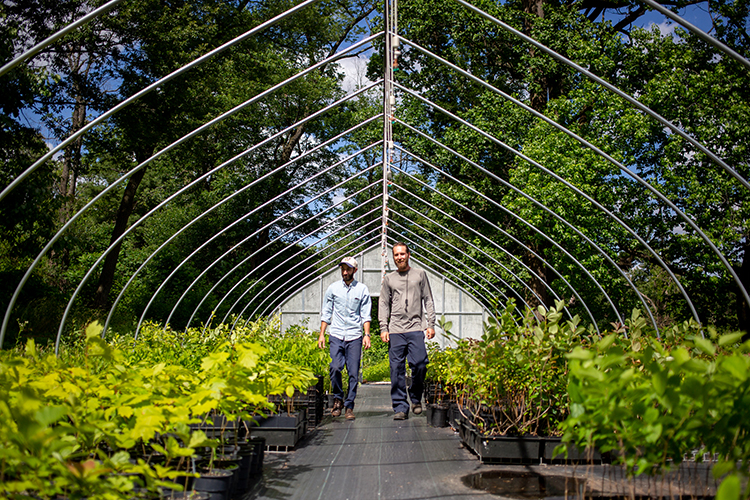


story by Claire Marie Porter
photography by Margo Reed
In his battle against invasive plant species in the Philadelphia region, Max Blaustein is taking prisoners.
Boards displaying various vine cuttings are tacked to a barn wall at the Greenland Nursery, which Blaustein has managed for the last decade. Chinese Wisteria vine, thick and bendy, a hairy English ivy clipping and the pale-colored flaky Japanese honeysuckle vine are lined up like criminal suspects.
These invasive plants seem omnipresent in our city. Brick walls often crawl with English, or “common,” ivy—purple wisteria drips romantically from balconies. Many of us likely grew up pinching off the ends of honeysuckle blossoms, gingerly drawing out the single drop of nectar.
They’re so common most would never guess they are some of the most destructive of invasive plants in the region—some are crowding out native species with excessive germination, others are physically pulling trees down.
The Philadelphia park system has one of the highest concentrations of invasive plant species in the region, says Blaustein.
Luckily, Philadelphia’s Department of Parks and Recreation is doing something to combat the problem. It’s hired Blaustein and nursery worker Dhan Parker to reestablish the century-old nursery off of Ford Road in West Fairmount Park and outfit the surrounding parks and woods with native plants.
While Philadelphia’s vast park system will ultimately serve as a home to the full-grown plants, Greenland is where the seedlings are born and raised.
the 13.5-acres of Greenland Nursery facilities have been in operation on and off since 1876, when it was established as “The Fairmount Park Nursery,” where trees and flowers were grown.
According to Department of Parks and Recreation spokesperson Theresa Stulman, its current name comes from “a failed real estate development known as the Village of Greenland, which was laid out prior to Fairmount Park being developed in 1868.”
“[Fairmount] initially appears to have been a heavily wooded area according to the detailed 1870 topographical map surveyed by park engineers,” says Stulman.
To a certain extent, it still is today. But many of the plants that now make up the forest were never meant to grow there in the first place.
“Most don’t know the dire situation its vegetation is in, due to increased pressure from invasive species of plants,” says Blaustein. “You could drive past [the woods] a thousand times, and unless you know what you’re looking for, you would never realize it’s in really poor health.”
What’s left is about 10 percent of the original canopy, he says, which is a couple hundred years old. The understory is almost completely stripped of vegetation, he says. The native seedlings are browsed by deer, while the invasive plants are left alone.
The team works off a list of 150 native woody tree and shrub plants, with varying levels of priority, says Blaustein. There are a few native species doing all right on their own.
“We were not seeing a lot of natural regeneration in the forest, so we’ve had to get involved,” he says.
Parker and Blaustein collect native seeds in the fall and bring them back to Greenland Nursery for processing. They clean, dry and store the viable seeds.
In one of the nursery buildings, little drawers and bags of seeds are stored in industrial-sized refrigerators.
“This is like their winter in here,” says Blaustein. Some seeds are large, like the white oak acorns, and some look like dust. Others, like elderberries, are already eagerly sprouting in the bag.
Their seedlings will help to reforest the city and its surrounding woods. The nursery germinates between 15,000 and 20,000 plants per year, and about 100 different species of native plants.
“Most of it’s your bread-and-butter species that should be here, and just aren’t,” Blaustein explains.
Three or four of those species are state-listed as rare or endangered, says Blaustein. Wafer ash, or hoptree, is one. It’s one of the few trees in the citrus family that is native to Philadelphia.
Occasionally, long lost or endangered native species will spring up after invasives have been cleared from an area and restoration work has been done. Annual wild rice, a threatened, marsh-loving grass, showed up at the John Heinz National Wildlife Refuge, and white thoroughwort, a rare princess of an herb with disc florets, appeared in the Wissahickon’s Houston meadow after restoration began. The team collected those seeds and propagated them.
A lot of the trees and shrubs take three to four years to grow to size, and each age group has its own nursery at Greenland. They tend to some 10,000 plants at a time. Inside the greenhouses are various stages of native life. Blaustein calls out the names as we walk past—“persimmons, dogwoods, hickories and hollies, native roses and elderberries.”
The team also propagates “live stakes,” or tree stem cuttings that easily root on their own. They look like twigs, but these willow and dogwood stems have a powerful rooting hormone and will grow into trees that strengthen the stream banks and prevent soil erosion. A thousand of these cuttings were planted along the Lansdowne and Montgomery creeks at the Fairmount Park Horticulture Center this spring.
The Greenland Nursery team also considers provenance in their approach. The idea that something may be native in both Pennsylvania and North Carolina, but the plant will have adapted to its unique locale.
“The closer you collect your source material, the better adapted it will be to local [threats],” Blaustein says.
Furthermore, the parkland that surrounds the creeks is the first line of defense when it comes to stormwater protections, says Blaustein.
“If those are healthy landscapes, the water is going to be a lot cleaner. It buffers the effects of climate change,” he says. “The benefits are huge.”
We need to learn what our natural landscape should look like, and it may be quite different than what we think. A healthy ecosystem may require some sacrifices—a bittersweet goodbye to Oriental bittersweet.
“The parks in Philadelphia are extremely important—they’re cleaning the air, they’re keeping the city cooler, they’re hugely important to managing stormwater,” says Blaustein.
It’s not only for the butterflies and birds, he says—it’s for the health of people.
where a hiker might see a beautiful forest scape while walking the Wissahickon, Tony Croasdale, environmental education program specialist for the Parks and Recreation department, sees an invasive monoculture of Japanese knotweed.
“There should be 20 species of shrub there, and there aren’t,” he says. “It’s still mostly invasives in the understory.”
Japanese knotweed is an invasive foliage that grows rapidly and densely, and it is nearly impossible to kill. It can grow through cracks in cement and even floorboards and easily crowds out native plants.
“When I first started out, I remember, I knew the invasive plants better than the natives. I knew what I was supposed to pull,” says Croasdale, but not what to keep.
Native species of plants aren’t commonly recognized by the average onlooker.
What would a healthy native landscape look like?
Our stream banks would have a lot more shrubs, he says. Instead of the monochromatic orange and white of apricot flowers and honeysuckle, you’d see bright white viburnums and blueberries, and bold orange-reds of persimmons and butterfly milkweed. There would be many more meadows, essential spaces necessary for ironweed and a host of other prairie plants that need temporary grasslands to grow.
To maintain that diversity the city is installing meadows in Cobbs Creek and Pennypack Park, says Croasdale.
The East Coast in general is heavily invaded, and Philly was the point of introduction for a lot of these plants.
“We can’t just let nature on its own anymore, unless we want things to go extinct,” says Croasdale.
Invasives would ultimately take over. In most cases, if you want to keep diversity intact, there will have to be a significant amount of interventions—this may mean installing deer closures, removing invasive plants or introducing a needed pest. And, likely, a period of time when the forests look bare. After clearing invasive species, there won’t be much left that’s green.
“There is also less diversity of invertebrates associated with alien plants,” Croasdale says. Most insects cannot consume the plant tissue of invasive plants. “We’re depriving insectivores of a lot of their foods,” he says. “Eye-level birds have declined. Could be deer—but could be that there’s a lot less insects available.”
That’s why these plants were introduced in Philadelphia in the first place, he points out, because they were resistant to bugs. Who, after all, wants plants covered in caterpillar holes?
Then there’s the issue of invasional meltdown, which the East Coast has been witnessing with the introduction of the Spotted Lanternfly. The tree of heaven, an invasive species from the same region in China as the insect, is omnipresent in Pennsylvania, giving the bug a foothold. More invasive plants means more opportunities for invasive bugs to colonize.
Philadelphia is fortunate. It has one of the largest urban park systems in the country—the Fairmount Park system includes 63 parks, approximately 9,600 acres of land—and the larger the area, the more resistance to invasive species.
Yet these lands are all highly manipulated. The goal, says Croasdale, is to get things back to what we understand to be a healthier ecological state—so forests are diverse in both species and genetic composition and structure.




